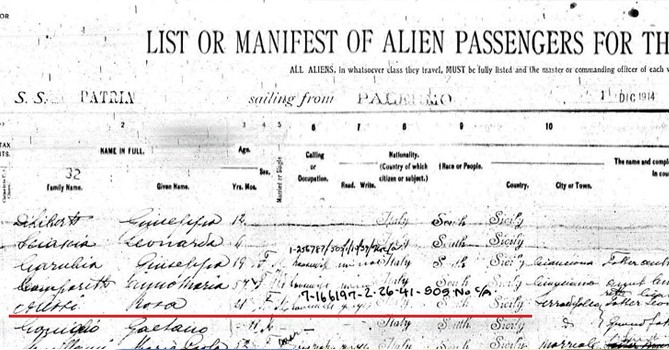
© 2015 50plus Senior News, All rights reserved.
The Search for Our Ancestry: Secrets of Ships’ Manifests
Angelo Coniglio | Apr 12, 2012, 6 a.m.

Question: I think my great-grandfather was born in Caltanissetta, Sicily, and I have a year of 1877. Where can I find his birth record? I have info about the family here in the United States. – D
Answer: Civil records for the Sicilian province Caltanissetta are available online on Ancestry.com and also on microfilms from the Mormon Family History Library. Caltanissetta is the name of the province and the name of the province’s capital city. Often when immigrants were asked their birthplace, they answered with the name of the province. So he may have been born in any town in the province.
The above question and answer are typical. Remember, regardless of your ancestor’s country, knowing his birth town is essential for extending your research. For any nationality, the town of birth may have been confused with the name of the state, parish, or county of origin.
The reader has some information. Does she have U.S. census records? If so, many census records give dates of immigration to the U.S., age at first marriage or number of years married, and whether a person was naturalized and when. Using that information, here are two approaches for finding an ancestral town:
-
Look for his naturalization information. Contact the county offices where he lived in the U.S. and ask where those records might be held. Search Ancestry.com or FamilySearch (www.familysearch.org) for naturalization records. That may result in a “Naturalization Index,” which identifies a federal court district, and a “Petition Number.” Using that number at the appropriate county hall or federal court may turn up a record there, or you can go to the National Archives (NARA) site (www.archives.gov) to order the record online. To order the record you need the person’s name and petition number or other identifying number.
-
Search Ancestry.com or Ellis Island’s site (www.ellisisland.org) for his passenger manifest, using the dates and personal information you have. If you find it, it may show his town of origin.
Even if the town’s name is illegible or absent from the manifest, it’s possible that it has helpful information. There may be a string of numbers or letters above the line with his name, which are possible indicators of naturalization papers that can be ordered from NARA. Details follow the discussion below.
If you find an ancestor’s manifest online, be sure to look at the image of the original. This was usually a preprinted form, with columns filled in by an official by hand, or later, by typewriter.
The manifest image shows information that is not on the transcription of the data. For one thing, you can look at the actual image of the name, age, town of origin, and other information, and may be able to decipher a word or phrase that the computer indexer couldn’t.
Beyond that, there are many columns, as on the example below, that are not transcribed in the printed summaries of the lists. Images of original manifests also reveal various marks, notations, and cryptic numerals associated with the names of some passengers.
The column headings on this lefthand page of a two-page manifest are:
- Row Number
- Family Name/Given Name
- Age, years/months
- Sex
- Married/Single
- Calling/Occupation
- Read/Write
- Nationality
- Race/People
- Country and City/Town
- The name and complete address of nearest relative or friend in country from which alien came.
These columns may be different for other years. The notation shown above, 7-166197-2-26-41-505 No C/A, means this: At the U.S. Court of District 7, certificate number 166197, on Feb. 26, 1941, a Certificate of Arrival was issued to Rosa Alessi, who had not previously received a Form 505.
Some immigrants were issued a Form 505 or Certificate of Arrival when they got off the boat. If so, when they applied for citizenship, they used these certificates to prove their legal entry to the U.S.
If no Form 505 was issued on arrival, the first step in the naturalization process, which may have been years later, was for the court to contact the Immigration and Naturalization Service to confirm the immigrant’s legal entry. The INS checked the passenger manifests and then issued a new Certificate of Arrival, noting that fact on the manifest.
To order naturalization papers from NARA, go to the National Archives online (www.archives.gov). You have to register and then click on the “Shop Online” box; then, click on “Order Reproductions” and follow the instructions.
When prompted, fill in the boxes with any information you know about the immigrant. In the box under “other information,” enter the Certificate of Approval number from the passenger manifest, as in the above example. If you also have the petition number, enter that in the appropriate box. The records cost $7.50—no charge if they are not found.
Once you get the naturalization papers, you may hit the jackpot. Many show the town and date of birth, date and ship of immigration, and the names, address, and birth date of every family member living with the applicant.
|
Write to Angelo at genealogytips@aol.com or visit his
website, www.bit.ly/AFCGen.
He is the author of the book The Lady of the Wheel (La Ruotaia), based on his genealogical research of Sicilian foundlings. For more information, see www.bit.ly/SicilianStory. |





